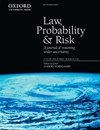The logic of uncertainty in law and life
IF 1.4
4区 社会学
Q1 LAW
引用次数: 1
Abstract
My central interest is decision making in the presence of epistemic uncertainty. A method appropriate for both specialized inquiries and everyday reasoning is based on credal logic, which employs multivalent degrees of belief rather than traditional probability theory. It accounts for epistemic uncertainty as unallocated belief. It holds that, when facing real uncertainty, if a person believes a and believes b, then the person believes a and b together. This brand of multivalent logic underlies and justifies how legal decision makers and the rest of us find facts in a world infused with epistemic uncertainty. Indeed, this article closes by showing the equivalence of multivalent logic and inference to the best explanation. By demonstrating this similarity in reasoning, I aim to shore up our faith in the logic of traditional legal reasoning.法律和生活中不确定性的逻辑
我的主要兴趣是在存在认知不确定性的情况下做出决策。一种既适用于专业探究又适用于日常推理的方法是基于可信度逻辑,该逻辑采用了多价置信度,而不是传统的概率论。它将认识上的不确定性解释为未分配的信念。它认为,当面临真正的不确定性时,如果一个人相信a并相信b,那么这个人就会同时相信a和b。这种多价逻辑是法律决策者和我们其他人如何在一个充满认知不确定性的世界中发现事实的基础和理由。事实上,本文最后展示了多价逻辑和推理对最佳解释的等价性。通过证明这种推理的相似性,我的目的是增强我们对传统法律推理逻辑的信心。
本文章由计算机程序翻译,如有差异,请以英文原文为准。
求助全文
约1分钟内获得全文
求助全文
来源期刊

Law Probability & Risk
MATHEMATICSSTATISTICS & PROBABILITY&-STATISTICS & PROBABILITY
CiteScore
2.10
自引率
28.60%
发文量
8
期刊介绍:
Law, Probability & Risk is a fully refereed journal which publishes papers dealing with topics on the interface of law and probabilistic reasoning. These are interpreted broadly to include aspects relevant to the interpretation of scientific evidence, the assessment of uncertainty and the assessment of risk. The readership includes academic lawyers, mathematicians, statisticians and social scientists with interests in quantitative reasoning.
The primary objective of the journal is to cover issues in law, which have a scientific element, with an emphasis on statistical and probabilistic issues and the assessment of risk.
Examples of topics which may be covered include communications law, computers and the law, environmental law, law and medicine, regulatory law for science and technology, identification problems (such as DNA but including other materials), sampling issues (drugs, computer pornography, fraud), offender profiling, credit scoring, risk assessment, the role of statistics and probability in drafting legislation, the assessment of competing theories of evidence (possibly with a view to forming an optimal combination of them). In addition, a whole new area is emerging in the application of computers to medicine and other safety-critical areas. New legislation is required to define the responsibility of computer experts who develop software for tackling these safety-critical problems.
 求助内容:
求助内容: 应助结果提醒方式:
应助结果提醒方式:


